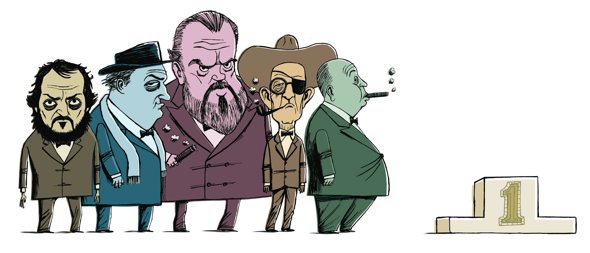The big talk about this year's list is that for the first time in the poll's history, Orson Welles' Citizen Kane (1941) didn't finish on top. It is now 2, behind Alfred Hitchcock's Vertigo (1958). But in a few places around the web, we find a different conversation taking place.
If you click on this link, you'll be taken to the introduction to the list at the magazine's web site. See the cartoon there? Okay, for those who didn't link, here it is:

From left to right, with their films in the top 50 in parentheses: Stanley Kubrick (2001: A Space Odyssey, #6 on the list); Federico Fellini (8 1/2, #10, and La Dolce Vita, #39); Orson Welles (Citizen Kane, #2); John Ford (The Searchers, #7); Alfred Hitchcock (Vertigo, #1, and Psycho, #35)
The cartoon serves as an indication of the obvious: the list compiled by the magazine's critics is a guys' list. Of the fifty films in the poll, only one was directed by a woman, Chantal Ackerman's Jeanne Dielman, 23 quai du Commerce, 1080 Bruxelles (1975).
Alyssa Rosenberg, writing in Slate, notes that this should not come as a surprise, given the astonishingly low representation of women directors in the major studios in the US and world-wide. But veteran critic and current yahoo blogger Thelma Adams makes a strong point about the poll's "inflammatory list": since it is "culled from a predominantly male, older-skewing clan of cineastes," of course it's going to have a bias.
There have been many excellent films directed by women throughout film's history, as Adams points out with a quick list of her own. And certainly some of them could have been included on the S and S list. Rosenberg is optimistic that as more and more women make films, the works of contemporary directors like Kathryn Bigelow (The Hurt Locker, 2009), Jane Campion (The Piano, 1993) and Lynne Ramsay (Ratcatcher, 1999) will appear on this list -- as might those of older generations like Lina Wertmuller (Swept Away, 1975). (It may also happen as some of these older critics, well, die off.)
But pointing out the bias of the critics' poll should not be about guy-bashing. What's at stake is who gets to decide what goes in the canon of important films. The Sight and Sound poll isn't the only locus of canonization. The U.S. Library of Congress honors and preserves films every year for their historical importance. The Oscars are also a form of canonization. And so is academia, where I work, and have been on the front lines of canon debates in film and in literature. (I know more than a few colleagues teaching in English departments who don't teach any literary works by women -- they didn't learn them when they were undergrads, didn't study them as doctoral students, and have little or no interest in teaching them today.)
Obviously, I have my own prejudices that are reflected in my syllabi. As a professor, I'm inclined to teach what I know best, going back to high school. But one of the things I learned as an undergrad was that what we learn and how we learn each has a political element, deliberate or not. When a list like this is so lopsided in terms of gender representation -- to say nothing of racial representation -- we owe it to our students to have dialogue about it, to encourage them to ask: why? Especially when the film on top is arguably one of its director's most misogynistic films. (I think its second only to Marnie.) It's not about tossing out this or that film from a list; it's about examining how one comes to make a list in the first place.
No comments:
Post a Comment